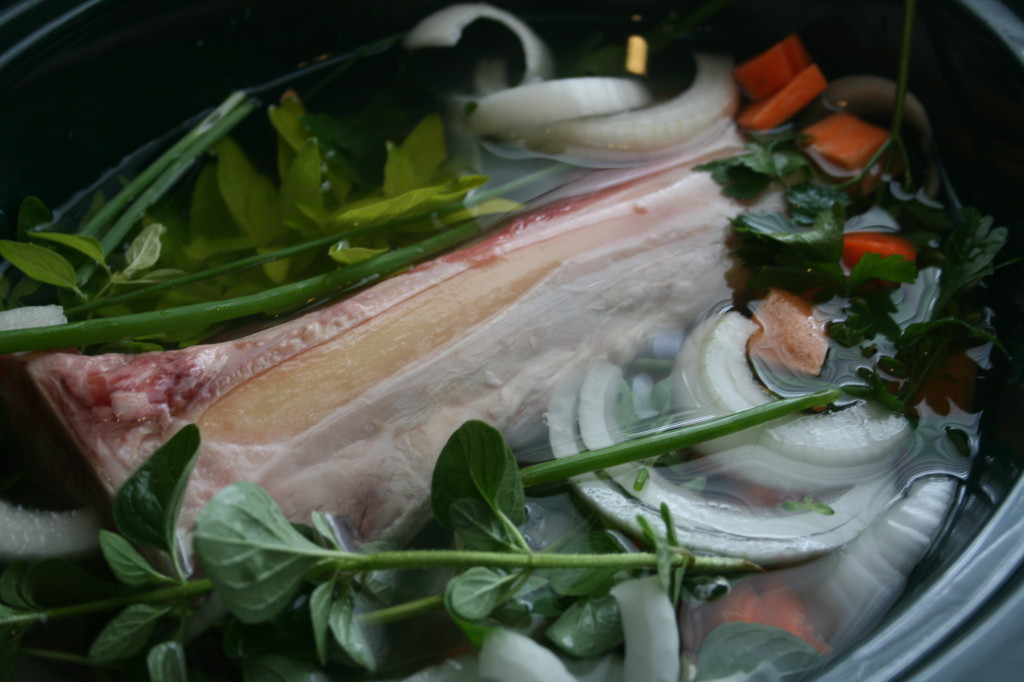 This stuff is liquid gold for our insides. I like to make it in a slow cooker instead of on the stove because I find that less evaporates and you end up with more broth at the end. The bones add high levels of calcium, magnesium, phosphorus, protein and collagen- all essential for our own bone, joint, skin and hair strength. The particular protein it contains is in the form of amino acids called proline and glycene. They are instrumental in wound healing and supporting the immune, digestive and nervous systems.
This stuff is liquid gold for our insides. I like to make it in a slow cooker instead of on the stove because I find that less evaporates and you end up with more broth at the end. The bones add high levels of calcium, magnesium, phosphorus, protein and collagen- all essential for our own bone, joint, skin and hair strength. The particular protein it contains is in the form of amino acids called proline and glycene. They are instrumental in wound healing and supporting the immune, digestive and nervous systems.
The vinegar helps draw all the minerals out of the bone but it will not add an acidic taste to the broth. You can use basically any herb and vegetable scraps, including carrot tops and left over bits and ends that weren’t pretty enough for other dishes. Even eggshells can be added in for extra nutrients. When it comes to the bone- organic, wild (for fish) free range and grass fed (for land animals)- all those labels that double the price, are especially worth it in this case. The bones store lots of the toxins that an animal obtains throughout its life. Plus, their mineral content is highly dependent upon their lifestyles. If they have lots of room to move and are fed a good, natural diet their bones are stronger, denser and have more of the nutrients that give bone broth its healing properties. If you try making it from a chicken that lived its life in a tiny cage, it just won’t have the same consistency. The true test of a good bone broth is if it gels once it cools- it should thicken up to a jelly like texture. If it doesn’t, it could be that there weren’t enough bones (usually 1 lb per 4 cups of water is sufficient) or that the bones were not great quality. It will turn back to liquid once heated. Most health food stores and butchers have good options in the freezer section or hiding in the back, and you need only ask for them.
The longer you simmer it, the better, but 12 hours is generally sufficient for fish, poultry and beef although 24 is more ideal, especially for beef. This can be a bit of a fire hazard if you go to sleep leaving it on the stove overnight and it reduces down too much, but it is safe in a slow cooker. There are some stories of broths that have been going for hundreds of years, their ingredients having been replenished regularly. I don’t have that kind of dedication but this is definitely something to make regularly if you have the urge. It uses up scraps and makes them into something incredibly nutrient dense. I like to use it for liquid in stir fries, it has no chemicals or preservatives like most store bought sauces do, or for mashing up with potatoes, it is lighter than gravy but still imparts a similar rich meatiness, and for stewing or poaching chicken, which I find ranges from a borderline salmonella threat to a dry, inedible mound when cooked without extra liquid.
- 8 cups water
- 2 lbs organic soup bone
- 4 carrots, sliced
- 1 yam, diced
- 2 tablespoons apple cider vinegar
- 8 sage leaves
- ½ cup fresh oregano
- ¼ cup fresh thyme
- ¼ cup chives
- 4 garlic cloves, halved
- 2 bay leaves
- 1 white onion, sliced
- Leave out until the last few minutes: 1 cup fresh parsley
- Once cooked and strained: sea salt to taste
- Option if using raw bones: bake them in the oven for around 30 minutes at 350° to strengthen their flavor.
- Add everything into the slow cooker, cover with the lid, turn the heat to high and leave for 24 hours. It should be on a slight boil the whole time. When there are around 10 minutes left add in the parsley and put the lid back on. Strain and discard all the solid ingredients. Add sea salt to taste, don't be afraid to add it in but just use a bit at a time. It will be kind of bland until there is enough salt to complement all the flavors. If you are used to powdered broth or bouillon cubes it might taste a little more subtle at first because most of those contain MSG and other additives that make the flavors hyper noticeable. It can be kept in the fridge for a few days or frozen for a few months. I like to freeze some in ice cube trays and small jars so I have portioned amounts that are easily accessible.
